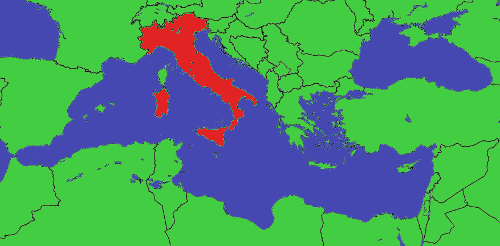
Circle the area on this map

B. Italy shares land borders with France to the west, Switzerland and Austria to the north, and Slovenia to the east. Italy is the third-largest cheese producer in the European Union, behind the more populous and larger nations of France and Germany.
D. The United States was the second-largest pasta producer in 2022, followed by Turkey, Egypt, and Brazil. More than a dozen Italian pasta-makers have been accused of dumping their product in the United States and face tariffs of over 100 percent.
B. The top wine-producing nation, Italy, is followed by France, Spain, the United States, and Argentina. When it comes to consuming wine, the United States drank the most, followed by France, Italy, and Germany.
C. Tomatoes are native to the Americas and did not show up in Europe until the 16th century. In Italy, tomatoes were first used for decoration and grown in flower gardens. Tomatoes were not incorporated into Italian cuisine until the late 17th century and early 18th century.